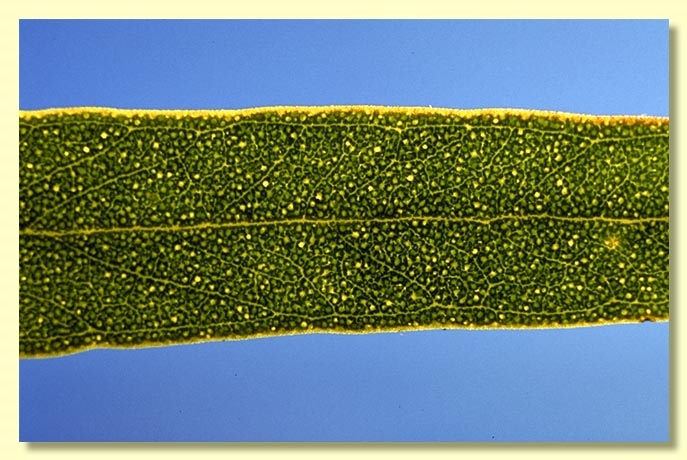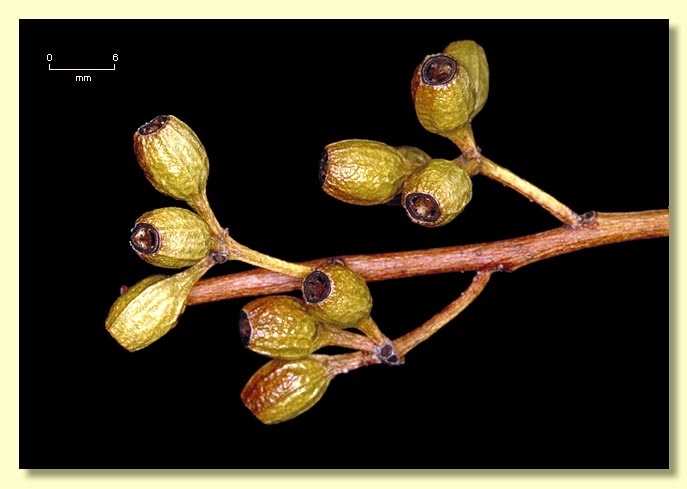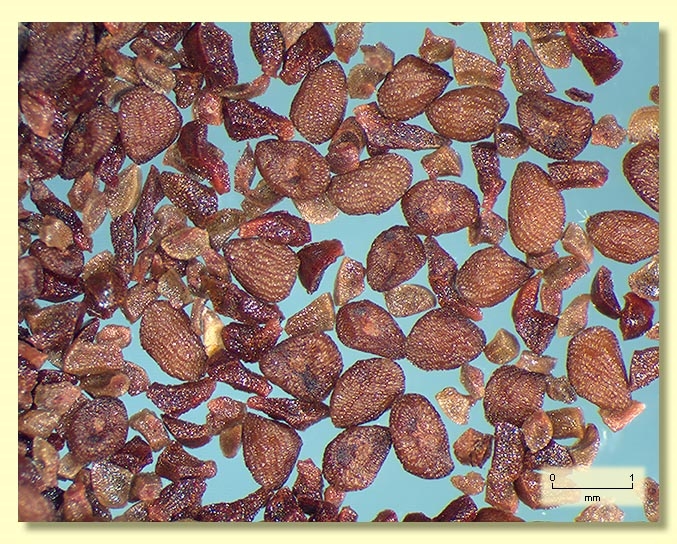Eucalyptus | Symphyomyrtus | Dumaria | Ovulares
Euclid - Online edition
Eucalyptus cylindrocarpa
T: Kurrawang, W.A., 2 Sept. 1926, J.B.Cleland 10; lecto: NSW, fide M.I.H.Brooker, Brunonia 4: 12 (1981).
Bark smooth throughout or sometimes with rough grey-brown loosely adherent thin flaky bark on base of stems, smooth bark pinkish grey to white, powdery at times.
Branchlets with oil glands in the pith.
Juvenile growth (coppice or field seedlings to 50 cm): not seen.
Adult leaves alternate, petioles 0.8–1.7 cm long; blade linear to narrowly lanceolate, sometimes falcate, (5.8)6–10(11.2) cm long, 0.5–1.3 cm wide, base tapering to petiole, margin entire, apex finely pointed, concolorous, very glossy, bright green, side-veins acute or obscure, reticulation moderate to dense or obscure, intramarginal vein present or obscure, oil glands numerous, irregular, island.
Inflorescence axillary unbranched, peduncles spreading to down-turned, 0.5–1.7 cm long, buds 7, 9 or 11 per umbel, pedicels 0.3–0.7 cm long. Mature buds cylindrical (0.7–1.3 cm long, 0.3–0.4 cm wide), scar present, operculum beaked or conical (0.25–0.6 cm long), stamens inflexed, anthers oblong, versatile, dorsifixed, dehiscing by longitudinal slits, style long and straight, stigma blunt to broadly rounded, locules 3, the placentae each with 4 vertical rows of ovules. Flowers white.
Fruit pedicellate (pedicels 0.3–0.6 cm long), long cylindrical to barrel-shaped, 0.6–1.2 cm long, 0.4–0.6 cm wide, disc descending vertically, valves 3, enclosed or near rim level.
Seeds dark to mid-brown, 0.8–1.6 mm long, flattened-ovoid, dorsal surface shallowly and clearly reticulate, hilum ventral.
Cultivated seedlings (measured at ca node 10): cotyledons reniform; stems square to rounded in cross-section; leaves always petiolate, opposite for 3 to 7 nodes then alternate, lanceolate to narrowly lanceolate, (3)4–9 cm long, 0.7–2(3) cm wide, dull, green to grey-green.
Flowering has been recorded in February.
A Western Australian endemic mallee species that grows on calcareous sandy loams and is common from Kellerberrin, Hyden and Varley east to Goongarrie, Lake Minigwal area, Zanthus, Balladonia and near Clyde Rock. It has smooth bark and the adult leaves are narrow and glossy green.
Eucalyptus cylindrocarpa belongs in Eucalyptus subgenus Symphyomyrtus section Dumaria because the buds have two opercula, stamens are strongly inflexed, ovules are in 4 rows on the placentae and cotyledons are reniform. Within section Dumaria it belongs to a small subgroup of nine closely related species which are together called series Ovulares. The series is further diagnosed by glandular pith, cuboid anthers, and seeds with a brown shallowly and clearly reticulate dorsal seedcoat.
Some of the species in series Ovulares are completely smooth-barked (E. cyclostoma, E. cylindrocarpa, E. exigua and smaller plants of E. oraria) while others (E. aequioperta, E. baudiniana, E. comitae-vallis, E. myriadena and E. ovularis) have rough bark over at least part of the stems.
E. cylindrocarpa differs from the other smooth-barked species in the series by having spreading to pendulous inflorescences and in particular from E. oraria by the very numerous leaf oil glands. E. cyclostoma, E. comitae-vallis and E. exigua all have buds that are constricted around the base of the operculum.













